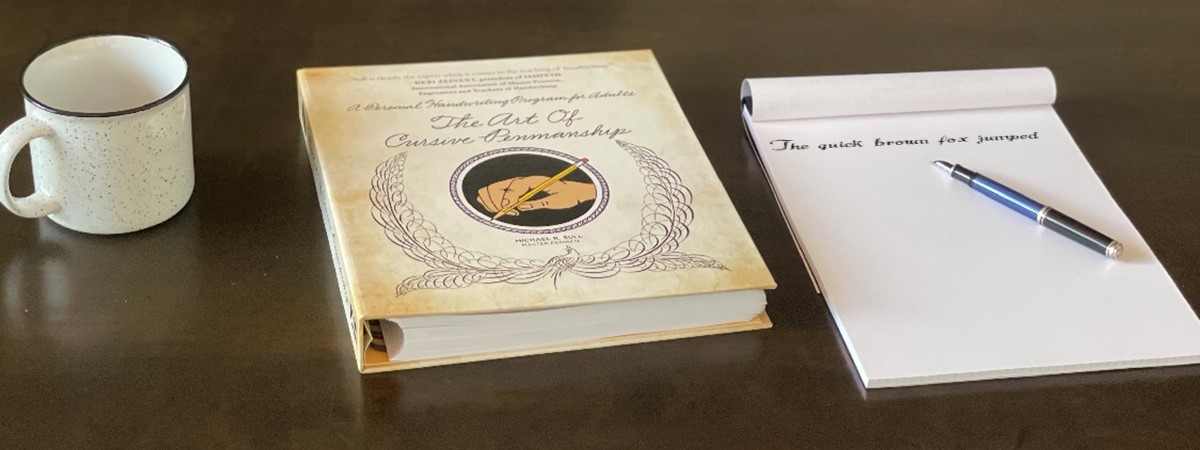
Like many people, for the longest time I wished that I could go back and learn to improve my handwriting. The problem is, even if I could FIND a course near me to attend, I knew I would never have the time for it. So, when I discovered “The Art of Cursive Penmanship”, it was an amazing gift.
With this book, I’m able to work at my own pace with nobody looking over my shoulder. And I can repeat the lessons over and over as many times as I need to in order to master them before moving on.
So, in this review I’m going to provide a short summary of everything that the book covers. I’m also going to give you some of my thoughts about its strengths and how you can use it effectively.
First, let’s begin with the man behind the book …
Table of Contents
About the Author: Michael R. Sull

Photo Credit: Alex Kasperavicius, via Wikimedia Commons
Michael Sull is a certified “Master Penman”. When I first heard that term, I wondered if it was a real thing. I thought it might be just one of those quite meaningless honorary designations given to everyone who paid the fee to join some guild or society.
Absolutely not. A master penman is a legitimately big deal; becoming a master takes years of commitment. You must learn many principles of advanced penmanship, but also be apprenticed to other masters. Then you must show that you have made a unique contribution to the artform. The bar is so high, in fact, that as of this writing, there are only eleven master penmen (and penwomen) in the world.
In this elite company, Michael Sull holds a distinguished place. He is a past President of the International Association of Master Penmen, Engrossers, and Teachers of Handwriting (IAMPETH) (you should check out their website, which is another amazing resource for handwriting).
Sull’s resume also includes some years working as a lettering artist for the Hallmark greeting card company, and authoring numerous books on penmanship and calligraphy. He was also personal calligrapher to former President Ronald Reagan for 13 years after Reagan left office.
His contribution
A crusader for reintroducing cursive to the curriculum of public schools, but also realistic about the challenges of seeing that happen, Sull is a frequent speaker at homeschooling conferences around America. Parents are keeping this tradition alive by teaching their children using Sull’s materials. It’s because of this extensive work in advocating for the teaching of heritage forms of handwriting, and his contributions of curriculum to that end, that some credit Michael Sull as “saving American cursive”. I’m sure he would not want to take all the credit alone, but there’s no question that he has been one of the major influences.
The Book
Previously self-published under the name “American Cursive Handwriting”, the full title is now “The Art of Cursive Penmanship: A Personal Handwriting Program for Adults”. That wonderfully describes what is actually a very comprehensive course. If you never had any instruction in cursive at school (or can’t remember any), this book will take you from scratch. The author assumes nothing.
- Publisher: Skyhorse; Illustrated edition (July 3, 2018)
- Language: English
- Spiral-bound: 272 pages
- ISBN-10: 1510730524
- ISBN-13: 978-1510730526
It is described as “spiral-bound”, which is correct, but it is also protected by a hard outer binder. So, this book is sturdy and utilitarian, including being easy to place on a photocopier (which we’ll get to in a moment). Given this binding alone, I am astonished at how affordable the publisher has made it ($19.99 in the US).
Click the images below to enlarge the front and back covers.
The Contents
Before the first chapter
Michael Sull begins by providing some handwriting samples (some prose and poetry, and a letter) that can all be used to copy out for practice. These are followed by “model sheets” that demonstrate the correct way to write each letter of the alphabet, and the ten numerical digits. Having this content up front is tremendously helpful later on when you’ll want to reference it quickly and often.
Chapters 1 and 2
These introduce the curriculum by discussing the importance of handwriting and the purpose of the book.
This course teaches the established forms of cursive handwriting that were taught during the first half of the 20th century, but in a manner that is more conducive to today’s pace of living than the hours of repetitive writing drills our great grandparents endured when they were school children. (The Author, p. 80)
Chapter 3
The author provides some of the history and heritage of American penmanship. You’ll learn about Platt Rogers Spencer (called “the father of American Handwriting”), and Austin N. Palmer who developed the “Palmer Method” of business writing.
Chapter 4
This chapter begins to prepare the reader for the act of writing by covering many of the important “mechanics”: posture, hand position, paper movement, what the author calls “the writing zone”, and details about letters and numbers.
Chapter 5
The student is finally ready to put pen to paper with a number of drills designed to develop the “muscle-memory” needed for good handwriting. These are some of the same classic exercises that were taught to students for over half a century. One “reviewer” on Amazon complained that this section is just “page after page of scribbling”, when they bought the book to learn cursive. But that misses the point entirely. Your ability to write cursive will never exceed the development of your motor skills.
Chapter 6
This deals with scales of writing. Standard scale is 1/8″ in height for the small letters. But there is also small scale, and advanced small scale.
Chapter 7
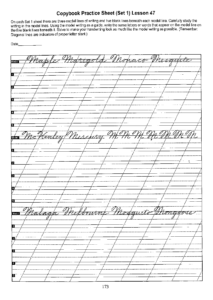
Chapter 7 is the longest chapter in the book — at 100 pages it’s 1/3 of the entire binder. That’s because it includes all of the lesson plans (86 in total!), complete with exercise sheets for practice. This is the “meat” of the program.
Chapter 8
Once you have worked your way through all the lessons, chapter 8 provides select quotes and excerpts from literature and poetry for even more practice.
Chapter 9
Just as a musician must first learn the fundamentals, but can then move on to improvising, if you’ve got this far in the book it’s time for some fun, and maybe even a little “riffing”. The author encourages you to experiment with artistic penmanship; some “flourishes”, etc.
Appendices
The resource pages at the end provide more blank practice sheets, a nice section on fountain pens (exciting to a fountain pen geek like me), a template for personal letters, and a helpful glossary of terms.
As you can see, this book is a wealth of information, training and helps.
A Personal Suggestion for How to Use “The Art of Cursive Penmanship”
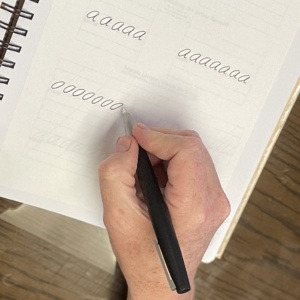
The book is printed on very good quality paper, which you could easily write on directly with a ballpoint or even a fountain pen. I don’t believe it would feather or bleed through at all.
But, of course, if you do write in it (with ink), the book is a one-use deal. So, some people may choose to do all the exercises with a pencil so you can erase it afterward to use the book again.
The Author suggests instead that you photocopy the exercise pages for practice, which is a perfectly reasonable suggestion. However, I chose a different way to do it. By laying a sheet of good quality, lightweight paper (52 gsm) on top of each page, I could easily see the lesson underneath and could trace the exercises (see picture).
By doing it this way you don’t have to keep making photocopies, and you can use a fountain pen-friendly paper (which copier paper definitely is not).
My Conclusion About “The Art of Cursive Penmanship”
In his opening overview, the author writes …
My goal is to make this the most thorough single-volume instructional source on cursive handwriting currently available. (The Author, p. vii)
There’s no question in my mind that he has more than succeeded in that goal. If there is a criticism to be made of the book, I honestly can’t think what it would be. The author is a gifted teacher, and this comes through very clearly in his methodical and complete approach.
I highly recommend “The Art of Cursive Penmanship” for anyone who has a desire to learn the fundamentals of American cursive, or improve their handwriting.
Everything is included. You will use it over and over again for many years to come as you continue to work on your writing.
Click here to check it out on Amazon
Have you used this book? Let us know what you thought by leaving a comment below.
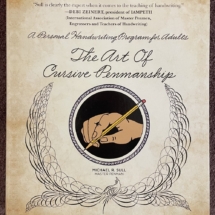
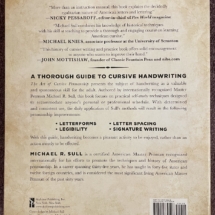
I bought a Spencerian script book set a while back. But because I’m a lefty, it doesn’t work nearly as well. So I’m thinking of trying to come up with a cursive writing system for lefties.